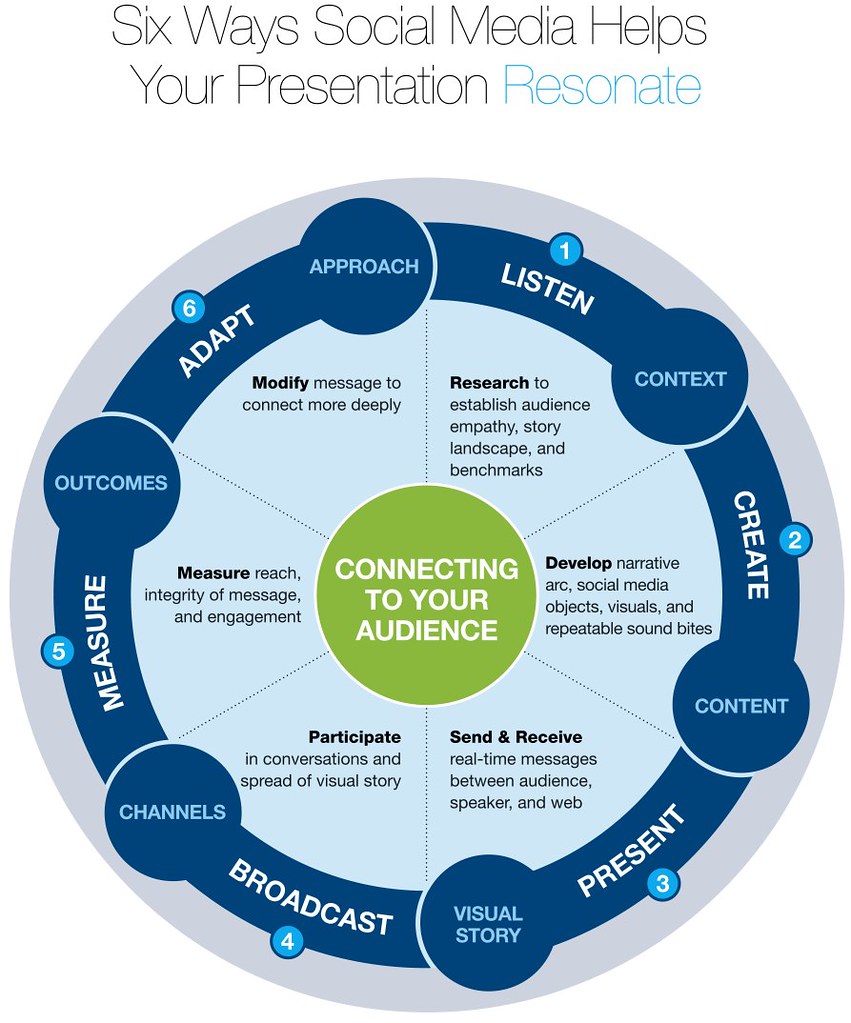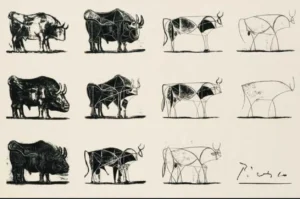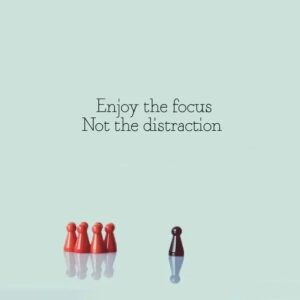Guest post by Nancy Duarte, founder of Duarte, author of Resonate and Slide:ology. Follow her on Twitter and read her blog.
Social media has forced presentations to become an interactive conversation. Presenters who embrace audience participation are connecting their audiences to their ideas in a more meaningful way. Using social media as a connection tool goes beyond just looking at the twitter feed to assess if you were boring or not. There are six ways to utilize social media while planning your presentation that will ensure an authentic connection and relevant conversation occur.
1.) Listen: The first step is to know your audience. Really know them. Listening to social media channels is the perfect way to find out what your audience is like. Where do they hang out (in life and on the web)? What unites them? What incites them? What keeps them up at night? When you know who you are talking to, you’ll come across as a friend to them when you present. It’s easy to persuade a friend. Genuine empathy with them will help you be perceived as sincere. Identify what your audience is currently believing or how they are behaving, and then develop a clear Audience Journey toward the transformation you envision. Next, you need to look at the context of your topic, community, or industry. What’s the story landscape of your competitors? Do you stand out? Is your approach better? Create a matrix for each channel through which your competitors communicate. Is their message clear? Could you tweak yours to contrast more?
2.) Create: Establishing the context above enables you to create your most resonant message. After you develop your narrative arc, yes, create some traditional slides, but don’t stop there. You need to also craft portable visual and word-based social media objects that can be distributed across channels. These might include: repeatable sound bites, viral infographics, slideshare documents or video. The best pick-up happens on social media channels with a well-crafted message. So hone a message and then sharpen it more by testing it with some friends and even test it by dropping soundbites on microblogs to see if they get repeated. Another way to build conversation is to present a partially developed idea and let your audience, through social media objects, migrate and refine it into a brilliant idea that spreads. Shareability is, of course, the essence of social media.
3.) Present: When you’re on the stage, embrace social media in the moment too. Some presenters hold a clicker in one hand and a feedback stream in the other. You can also insert slides at appropriate moments that display an array of live chatter. Or auto-tweet live from the stage by pre-writing tweets that get sent out when you click to advance your slide. Enlist a photographer to keep the Flickr stream full of images before, during and after your talk. Feeding your audience social media objects they can forward around or react to makes them feel like part of the story. During the presentation, hire live-sketchers or visual note-takers to tweet images of what they see while you talk. Don’t let the conversation happen behind your back, deliberately create objects that fuel overt conversations.
4.) Broadcast: Hopefully you already have well-developed channels to spread your message through. The currency of social media is reciprocity. So if you haven’t yet spread the ideas of others, yours might not get much traction. You can have great objects and smart concepts, but if you haven’t built a community on the various channels your idea might not go very far. To broadcast video, you can livestream it or capture and post it as archival on YouTube and Vimeo, and also syndicate on sites like fora.tv. Give permission to the audience to microblog plus invite bloggers and media to cover your presentation. Hire a fun person to host a video crew to capture the audience reaction and post it immediately following your presentation. E-mail your base to look at and expose your idea. There are endless ways to get the ideas from your presentation out there.
5.) Measure: The most important component of assessing effectiveness isn’t necessarily how many people you reached—but did you reach the right ones? Did your messages stick, stay intact and resonate? The integrity of your story can be as important as the population it reaches. Digging through the statistics generated from your talk can be daunting. I heard Katie Paine once say that you need an Abby (from NCIS) to dig into your data to really understand how well you connected to your audience. This step is often overlooked, but it is very valuable.
6.) Adapt: Armed with insights into how the social web treated you and your language, you can make informed decisions on how to modify your message, delivery and visuals so you resonate more deeply in the future. Capture and apply those findings immediately to make an even more meaningful connection with the audience the next time around.
If you look at TED as a media phenomenon, there have been 400 million presentations viewed so far. When a presentation is developed and distributed with an eye to these new strategies it can change the world. (Click image below for full size).







The 6 steps cannot be anymore clearer than this! I think most companies have no problem with the first half (1-3) and the problem starts when they reach 4-6. Common problems may include the lack of time to actively participate, clueless about measuring success and how to adapt their message to their followers (because they do not participate). What would be your suggestion for situations such as these? 🙂
Hi Jan, great question. The sad thing is that most folks think that when they are done presenting, that they are done. If you care about your audience and message, really care, then taking steps 4-6 would not feel like an option. As measurement tools get more sophisticated, the process should get easier!
These recommendations are spot-on & of incredible value!
Last month I spoke at our annual industry event about Facebook marketing. Before even starting the preso sketch, I looked at the attendees & followed them in various social places to get an idea of where they were coming from. This was incredibly helpful so that I wasn’t offering ideas too remedial or beyond what they could absorb.
After the event I received feedback on the usefulness of the information shared & how thankful they were to have actionable tactics they could implement immediately.
In the future, I look forward to adding more of these steps into my presentation to groups who are ready for that level of engagement.
Hi Gina,
You’re a rare presenter. You really tried to walk in your audience’s shoes and observe them. This is brilliant. By taking a walk in their shoes, it does change the way a presenter communicates to them. Great job.
Regarding #3, any inexpensive suggestions for when the conference doesn’t offer internet access for speakers?
Great questions Michele,
You could have someone on your team sit in the audience or at the office text you any significant insights from the conversation on the back-channel. That way only the important insights get addressed and you’re not having to filter the stream, only respond to it.
Hi Brian, more great insight and I believe that some people are really developing a natural flair for what works with Social Media and Social Media marketing.
Whatever we do now and however we chose to present it, we can share it so easily and as sharing becomes more of a habit, Social Media becomes more appreciated. It isn’t hard to share a Blog post or a YouTube or Vimeo link on Facebook or Twitter, because we are doing these things naturally now! Now it’s 2nd nature to a lot of people and as others see the potential the good word spreads!
Do I publish a Blog article and neglect to put it on Twitter, Facebook, StumbleUpon, Digg, etc.. never, because I wouldn’t be doing my job properly. I’d be letting myself down.
I love your idea of having people Tweeting about the presentation you are making, very inventive, yet a simple idea and I think sometimes we don’t need to over analyse the situation because Social Media offers us so much scope.
We can make a YouTube video with photographs for next to nothing, we don’t need a film crew, we only need a mobile phone with a camera! Easy!!
Thanks for the continued inspiration, all the best, Peter
When I first started using the auto-tweet tool that you mention in presentations it was more of a distraction, as audiences switched off from the content and became more interested in how it was being done. Several times I have had the conference #hashtag and back-channel fill-up during my presentation with talk and speculation of how I was doing the live tweeting. So now I let audiences know right up front what I am doing and what they can expect from my presentation. A key part of this is in creating the “social objects” you refer to and embedding them within the live-tweets and delivery of the material so audiences get a prepped stream of key points, images and links that they can use instantly as they listen to you. I also make sure my pres. is uploaded prior to the event into the relevant event channels, including slideshare, and at the end of the pres. have a slide that both live-tweets the links and throws them up on-screen. Savvy audiences really appreciate it as it helps them engage and connect with what you are saying, learn from it, and spread it.
One of the criticisms of this approach though is that you could be encouraging people to have side-track conversations during your presentation, which may lead to them not paying full attention and missing key points that you might make. It’s for this reason that I know some conference organisers don’t have a visible twitter back-channel, or restrict it to panel debates where audiences are then encouraged to participate, or within breaks.
Conference organisers are now also much smarter at employing live-bloggers, event-tweeters and social media photographers, even providing them with specific tools and channels to use, so be prepared for these if you are speaking. And some are now going even further by putting together specific social media teams to run event campaigns. Good examples of this are Like Minds, #LikeMinds (DOI), who dominated Social Media week earlier this year by having a comprehensive social media plan (http://synthesio.com/corporate/wp-content/uploads/2011/02/Social-media-week-analysis-1.pdf), EuroRSCG London who sponsored Social Media World Forum and took a team to amplify their presence, and Orange who built a “live” portal and put together a SM team for their global business conference.
Great insights Andrew. I haven’t seen conf organizers do a concerted social media effort. Nice to see it’s on their minds. Thanks for the note.
Great post today. The information you provided is sure to help presenters take social media and their presentations to the next level. For presenters who really want to go above and beyond and create an interactive community, they can go live with their presentation by broadcasting it via the internet. At the same time, the presenter or an aid can monitor Twitter and Facebook, etc. for comments and questions by viewers which can be addressed in a Q & A session at the end of the presentation.
Great post Nancy. Thanks for sharing some great insights I’ll definitely be using them moving forward.
Hello Nancy, humble apologies for not saying thank you for the article when I originally left a comment. I was busy and just got on with reading without understanding it was written by you! I have look at your Facebook and added it to my favorites so all my readers can benefit from your thoughts and ideas. I am also following you on Twitter! Based on how interesting and informative this post is, you have gained me as a long term fan. Best regards, Peter
You assume that the audience in question uses social media. Take physicians, for example. Specifically OB/GYNs. Few in public spaces. Unlikely there’s a backchannel dialog taking place – few, if any, on Twitter. Medical meetings don’t even offer wifi.
While I like the construct it would appear to apply to those high on the Forrester ladder. Nearly all physicians haven’t made the first rung.
A great article, thanks for sharing these great insights with the world. Useful infographic too.
Social media’s presence in business continues to grow. This is a good example of another way to use it. However, the success might depend on the industry in which the presentation is being given.
Love the idea of having a feedback stream on stage and using live chatter! I’ll have to try that.
To start: Great post! I typically am creating presentations for potential public relations and strategic communication clients, as well as some informative presentations to other industries (usually about the usefulness of social media). However, I have the one recurring issue I run into is that the audience is not on social media platforms to properly gauge and “Listen” prior to creating a presentation. With that being said, it is still a very useful and insightful step that every presenter should start with because it then gives you the knowledge that they don’t use social media.
Integrating social media objects in a presentation (usually using prezi or sliderocket) are usually a huge plus. It really drives the message home of how interactive and useful social media is. Lastly broadcasting the presentation. I usually dont do this step but am realizing the importance of this step. It really allows your story to spread and gather more feedback.
Thanks for this easy to follow and concise step-by-step presentation process Nancy!
Great post, I like the visual representation.
At a recent conference, the speaker showed us the twitter handle and encouraged us to do live tweets. The audience eyes glazed over. They had no idea what to do.
Here in the UK we are seeing more and more Twitter activity during seminars and presentations with larger public. In my experience, not so much when the audience is just a group of people around a table or a screen.
Very nice illustration/infographic. Because of the huge of social media, entrepreneurs should definitely learn about this medium and not take it from granted because it is free and easier to navigate that most marketing strategies. Thanks for sharing.
Great post, Nancy. The infographic is especially powerful. It all circles back to listening, doesn’t it? Sometimes it can be difficult for presenters to really hear their audience’s feedback out of fear. But, as presenters if we can truly listen and adapt to the needs and wants of our audience, the ability of our message to truly resonate increases tenfold. And social media is the beautiful tool that allows us to do this in real time. Love it! Thank you.
5th and 6th step are very important..